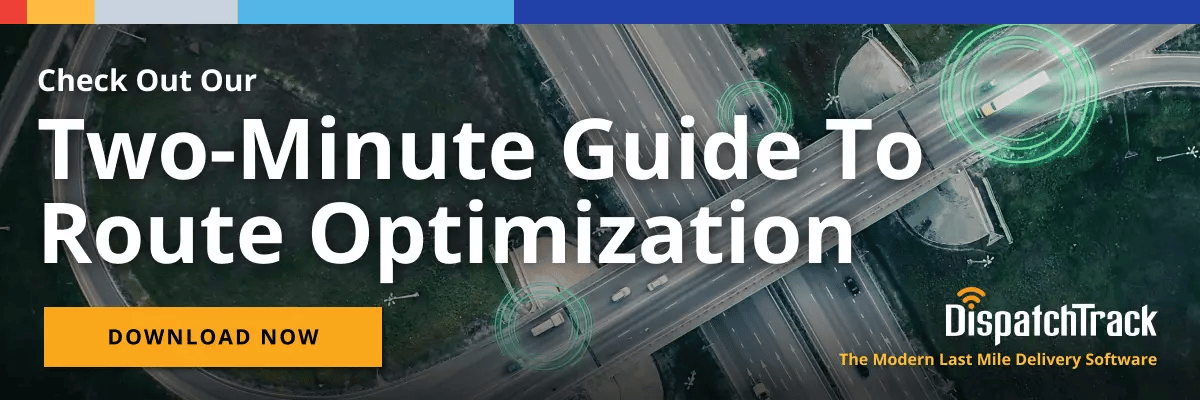Route planning is crucial in improving both the customer delivery service experience and your business's bottom line. Aside from improving your fleet's daily delivery performance, route planning is useful in identifying the most effective delivery strategies to use and the possible effect of any changes in how you get the right goods to their final destinations. At the same time, effective route planning is crucial for setting delivery ETAs that you can actually meet, thereby making it incredibly important for keeping delivery promises to your customers.

That, in a nutshell, is why dynamic routing technology is so important for successful last mile deliveries.
Static Routes vs Dynamic Routes
Static routes are characterized by fixed routes and inflexible sequences of stops. This means that delivery drivers follow the same route and sequence regardless of delivery volume and order mix.
Dynamic routes, on the other hand, are created according to the delivery volume and order mix of a given day. Under this route planning type, the stop sequences and route paths are unique every day according to the customer and order mix. The goal here is to ensure that deliveries are made at the promised delivery times while ensuring that the routes are the most cost-effective ones for the firm.
Businesses that are handling a considerable degree of variation in orders every day are better off choosing dynamic routing. As online shopping has increased exponentially due to the COVID-19 pandemic, the ability to ensure delivery efficiency by finding the best use of your capacity each day of the week is increasingly crucial to getting ahead of the competition. Dynamic, real-time route planning helps businesses accommodate a bigger clientele with the same number of trucks and drivers while lowering the costs to accommodate high order volumes.
That said, dynamic route planning is only feasible with the right delivery management tools—specifically dynamic routing software. Even the most seasoned human route planner does not have the computing powers required to evaluate all the possible combinations of route sequences to find the most cost-effective routes, to say nothing of assigning accurate ETAs to each stop.

The Advantages of Dynamic Routing Software
More Optimal Routes
Simply put, dynamic routing helps find the optimal routes, allowing enterprises to make the most out of their assets. This routing method factors in different variables affecting delivery times such as transportation speed, weather conditions, traffic flow, and service time—to name just a few—at the same time ensuring that drivers are traveling the shortest distances between stops. This also helps companies to cut down their carbon emissions and pollution as delivery teams minimize miles traveled.
Improved Fleet Efficiency
Fleets can improve their productivity by leveraging dynamic routing software to complete more deliveries in less time via optimal scheduling and route plans. Dynamic real-time routing also empowers the fleet to adjust delivery schedules on the fly without causing havoc to delivery teams' schedules for the day. This means fleets can maintain and increase their efficiency even as new orders are added to the already-planned routes.
Improved Visibility Over Drivers
Drivers now and then will encounter unexpected scenarios while driving. Situations such as road closures or sudden downpours may happen on pre-planned delivery routes. The best route optimization software helps fleets deal with unexpected situations by letting you adjust routes according to real-world and real-time scenarios. When your technology is fully connected and handles the last mile from end to end, you can also send updates to delivery stakeholders including customers about the changes made.
The key here is to find delivery route optimization software that goes beyond planning to offer dispatchers and fleet managers real-time visibility on their drivers. This allows fleets to monitor drivers' location and statuses so they can see which orders have been completed, which deliveries are in danger of being late, etc. This helps dispatchers and managers to identify disruptions and delivery exceptions on the fly and efficiently work to address them in real time.
Lower Fuel Costs and Reduced Empty Miles
Dynamic routing enables you to find the most efficient routes, which in turn cuts down your fuel costs. This cost-saving is significant as fuel costs are often the biggest expenses of any fleet. Dynamic, real-time route planning also allows you to keep track of fuel consumption and helps you implement better route management strategies over time.
Similarly, this kind of routing enables you to reduce empty miles by finding the most fuel-efficient and quickest routes. Rather than driving extra miles because your stops aren’t sequenced optimally, dynamic routing helps you cut through the complexity to ensure that your drivers are dispatched with routes that are actually feasible.
Improved Communication with Customers
One of the best ways to maintain brand loyalty and increase customer satisfaction is to ensure effective communication with your customers. Dynamic routing software helps in this area by providing accurate expected times of arrival (ETAs) and informing customers of when to expect their orders. The right logistics application will also offer automatic alerts and notifications to customers informing them of delivery delays if an unavoidable situation comes up. But when everything goes smoothly, you’ll be able to delight your customers by making strong delivery promises and actually keeping them with consistent on-time delivery performance.
Lower Operating Costs
Aside from reducing fuel consumption, dynamic route planning also helps businesses save money in other areas. For one, it helps drivers complete more deliveries in a day, thus minimizing the need to pay overtime. Finding the most efficient routes also helps lower vehicle maintenance costs since drivers will be traversing shorter distances.
Plus, many businesses tend to acquire more delivery vehicles and hire more drivers to accommodate higher order volumes, rather than evaluating how to make the most out of their current resources. A dynamic routing solution can help your fleet maximize asset utilization, allowing you to do more without having to buy new vehicles or add more drivers to your current roster. Lower fuel, labor, and vehicle costs, along with better asset maximization, can go a long way in keeping operating costs low.
In the end, dynamic routing enables enterprises to improve route planning, cut down costs, and increase profit margins. It helps companies adapt to changing requirements while consistently meeting customers' demands. By maximizing resources, ensuring timely deliveries, and reducing operating costs, dynamic routing solutions can act as an invaluable tool for ensuring long-term growth and sustainability.